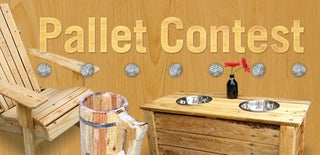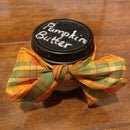Introduction: Wood Storage Shelves Via Recyclable Pallet
I have been reading the many different creative ways that people have come up with for reusing pallets via Instructables. I started to collect my own pallets, but because of the lack of time to be as creative as others, I found that I was collecting a lot of pallets with no creative outcomes. I was storing them on my patio next to my house and soon realized that I needed to do something with the wood because I was starting to create a fire hazard. I attacked my pallet stack one Saturday afternoon and tore many of the pallets apart. Of course, that didn't solve my problem. I still had random boards scattered all over my patio. Thus this wood storage was created using the following:
Pallet Wood
Grabber Screws
Cordless Impact Driver (A drill would have been better, but it's the only drill species I own)
This project can also be completed using nails and a hammer, though it would be a lot faster and easier if those nails went through a nail gun.
The picture associated with this step is of the finished product. I put the storage shelf away from the house and laid the leftover pallet on top of it.
Step 1: Step 1: Pallet Tearing and Pairing
The first thing that I did was to tear apart the pallets that I had. I won't be going into much detail on that because I'm assuming that you can all figure that out. If you can't, I'm pretty sure there are Instructables out there that can help you.
After tearing apart the pallets I lined up the 2x4s according to similar length. I ended up with 4 that were approximately 3 ft, 3 that were approximately 5 ft, and 4 that were about 2 ft. This storage shelf didn't have any cut pieces since I don't own a miter saw and didn't want to use a hand saw on them, so I just used the approximate lengths. If you want to make it more uniform then designate some specific lengths and cut them accordingly.
Step 2: Step 2: Adjoining One Side
After aligning the pieces, I took one of the 3 ft lengths and one of the 5 foot lengths and laid them down on the ground, as can be seen in the picture. Using the screws and my impact driver, I predrilled two holes about 2-3 inches from the edge of the 3 ft board, as shown. I lined up the 5 ft length with my two predrilled holes and sank two screws through the 3 ft piece and into the 5 ft piece.
I then repeated the same procedure on the opposite end of the 5 ft piece as can be seen in the third picture. This will be the front or back piece of the shelf.
Step 3: Step 3: Adjoining the Other Side
To make the other front/back side of the shelf you do the exact same thing as in step 2, except since I didn't do any measuring, I stacked the wood on top of each other to get a rough estimate of where I should be predrilling and sinking my screws. This can be seen in the picture. It's mostly easily done by putting one of the 3 ft pieces on top of the already adjoined 3 ft piece and based on the existing screws in the adjoined 3 ft piece, eyeball where to predrill your the next pair of holes. You can either mark it with a pencil or you can scratch a line into the wood using the screw, or you could just push the screw into the wood to make two very small indents.
Step 4: Step 4: Connect It All
After you have assembled the front and back parts of the shelf all you have to do now is to give it some depth. Using one of the 2 ft pieces I predrilled 4 different holes near the end of the wood. I found that if I offset the holes so they weren't directly lined up with each other length wise then the wood have less of a tendency to split. After predrilling the 4 holes I stood up one of the adjoined pieces talked about in steps 2-3. While holding the adjoined piece with a shoulder and a knee I put the 2 ft board right above the 5 ft length and sunk screws into the 4 predrilled holes.
I didn't realize until know that it probably would have been so much easier if I had laid the front adjoined piece vertical, with the 3 ft piece laying on the ground and the one that was up in the air resting against the house. Then I could have attached the 2 ft piece with a lot less difficulty.
After you get one 2 ft piece attached to the first adjoined piece then pick up the second adjoined piece and repeat the steps already mentioned. You'll need to attach a second 2 ft piece to the opposite side of the 2 ft piece that you just got done attaching. The second picture shows the adjoined pieces upside down (so the bottom of the shelf structure is on top). The attached 2 ft piece is on the far side of the picture. There is a 2 ft piece on the near side, but it's only resting on top of the adjoined pieces and is not yet connected.
Step 5: Step 5: Long Shelf
Flipping over the structure so it's right side up, I grabbed two more 2 ft pieces and repeated the process of step 4, but higher up on each side. The 2 ft piece is about 1 ft or so from the top of the 3 ft pieces. Attach them using 4 screws, predrilled holes, the works. Again, leaning it up against the house would have been easier to attach the 2 ft pieces. If you want these two pieces to be exactly across from one another you can measure from the top of the 3 ft pieces down, or if you wanted you could put a longer board across the two of them and adjust them until they are level (hint: you'll need a level to make them level). I figured it didn't matter so I again just eyeballed it.
Step 6: Step 6: Extra Support
Lastly, I grabbed the last 5 ft piece and at the top of one of the adjoined pieces (it doesn't matter which one you pick) I again predrilled two holes and screwed in the 5 ft piece. I layed the whole frame down to two of the 3 ft pieces were lying down and the 5 ft piece that was being attached was also laying down on the ground.
I picked up the frame, moved it away from the house, and then stacked the left over wood pieces on top of it. It's certainly not anything fancy, but it keeps the wood away from the house, and it's off the ground too.
Step 7: Final Notes
The cost of the project for me was $0. That's because I had all of the supplies on hand. It took me approximately 2-3 hours to complete this project. It would have been faster if I had been using a drill instead of an impact driver and if I had this handy instructable to read off of while I was doing it instead of trying to figure it out as I went along.
Please remember that often times pallets have old nails, screws, staples, and straps, some of which are rusted. Caution should be taken when working with metal and wood. If you happen to get cut or pierced by a piece of metal, even if it doesn't look rusted, it would probably be a good idea to visit your doctor and ensure you have your tetnis up to date. In attempting to duplicate this project you understand and take the risk that there is the potential for injury. You've been warned.
I noticed after I finished, that the connections between all of the wood pieces still felt a bit woobly and not very secure. There were small gaps between some of the wood pieces which I am guessing is because I didn't apply enough pressure on the two pieces while I was screwing them together. I think that this problem would be solved by leaning the adjoining pieces up against the house while screwing in the necessary pieces. A nail gun may have also fixed this problem as well, though I will be the first to admit that I am a novice when it comes to wood working.
I thought, as simple as a project as it is, that it was a lot of fun and a good educational experience. Seeing as how I am very new to woodworking if any of you have any comments or suggestions for me I'd be very glad to hear them.

Participated in the
Pallet Contest













